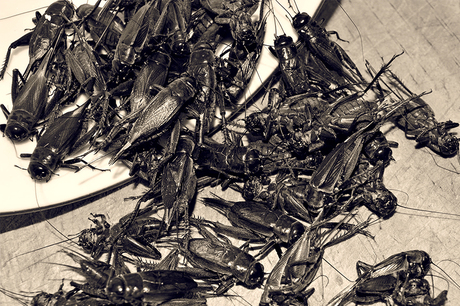Cricket farming in New Zealand

Alex Figg is one of three founders of Critter Farms, an enterprise raising an orchestra of crickets for food.
The University of Auckland final-year Masters of Architecture (Professional) student was researching sustainable architecture when he learnt the World Health Organisation (WHO) had declared our current agricultural practices unsustainable.
According to the WHO, by 2050 an estimated 9.3 billion people will require feeding, with protein being the nutrient in short supply.
While pondering how this would impact on future land use and architecture, Figg and co-founder Elliot Olsen began investigating alternative protein sources.
They discovered that crickets were a sustainable, efficient and nutritious protein source which far outperforms traditional livestock. The insects use 2000 times less water, 12 times less feed and emit a hundred times fewer greenhouse gases compared to beef.
High in protein, essential salts, vitamins, minerals and omega 3 and 6 fatty acids, crickets are a super food of sorts.
While the global population grows and becomes increasingly urban, there will be less arable land available for agriculture.
“Crickets don’t require earth to be farmed, so they can potentially utilise vertical space which can be designed into buildings,” said Figg.
With a personal goal to use truly sustainable practices in his life and work, Figg has also been researching a new biodegradation method to recycle problem plastics, utilising advances in environmental science. The idea recently won a Velocity Innovation Challenge Prize worth $1000.
In between plastic recycling and finishing his architecture degree, Figg and his colleagues at Critter Farms are prototyping cricket farming in Auckland with the target of helping enable a paradigm shift away from our dependence on land for food.
With approximately two billion people already eating insects to supplement protein, if you’re not keen on eating whole crickets never fear...
“The crickets are toasted and ground into a nutty flavoured powder which can be used as a tasty, high-protein food ingredient. I recommend you try it,” said Figg.
Chocolate consumption trends in the US
Chocolate sales hit a new high in the US as it remains an 'affordable treat' duing...
Ready-made infant, toddler food study finds some falling short on nutrition
Some ready-made foods for infants and toddlers being sold in Australia are not meeting WHO...
PepsiCo achieves 3.5 Health Star Rating with chip ranges
PepsiCo Australia has achieved a 3.5 Health Star Rating (HSR) for its low-salt and baked potato...














